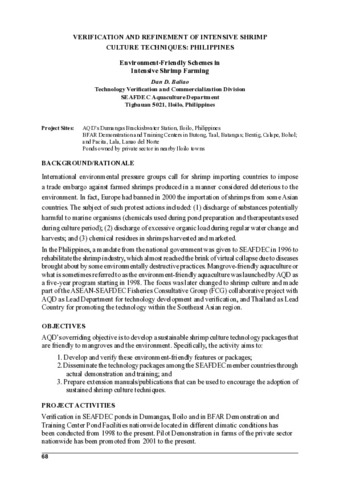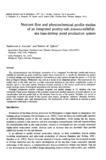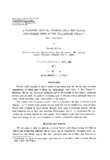Environment-friendly schemes in intensive shrimp farming.
- Global styles
- MLA
- Vancouver
- Elsevier - Harvard
- APA
- Help
Share
抄録
International environmental pressure groups call for shrimp importing countries to impose a trade embargo against farmed shrimps produced in a manner considered deleterious to the environment. In fact, Europe had banned in 2000 the importation of shrimps from some Asian countries. The subject of such protest actions included: (1) discharge of substances potentially harmful to marine organisms (chemicals used during pond preparation and therapeutants used during culture period); (2) discharge of excessive organic load during regular water change and harvests; and (3) chemical residues in shrimps harvested and marketed.
In the Philippines, a mandate from the national government was given to SEAFDEC in 1996 to rehabilitate the shrimp industry, which almost reached the brink of virtual collapse due to diseases brought about by some environmentally destructive practices. Mangrove-friendly aquaculture or what is sometimes referred to as the environment-friendly aquaculture was launched by AQD as a five-year program starting in 1998. The focus was later changed to shrimp culture and made part of the ASEAN-SEAFDEC Fisheries Consultative Group (FCG) collaborative project with AQD as Lead Department for technology development and verification, and Thailand as Lead Country for promoting the technology within the Southeast Asian region.
Suggested Citation
Baliao, D.D. (2004). Environment-friendly schemes in intensive shrimp farming. In: Promotion of mangrove-friendly shrimp aquaculture in Southeast Asia (pp. 68-71). Tigbauan, Iloilo, Philippines: Aquaculture Department, Southeast Asian Fisheries Development Center.
Type
Meeting reportCollections
Related items
Showing items related by title, author, creator and subject.
-
Asian shrimp situation
Carreon-Lagoc, Julia; Southeast Asian Fisheries Development Center, Aquaculture Department (Aquaculture Department, Southeast Asian Fisheries Development Center, 1990) -
Nutrient flow and physicochemical profile studies of an integrated poultry-salt-Artemia-milkfish-sea bass-shrimp pond production system
Jumalon, Nepheronia A.; Ogburn, Damian M. (Wetteren, Belgium: Universal Press, 1987)The physicochemical and biological parameters of an integrated flow-through poultry-salt-Artemia-milkfish-sea bass-shrimp pond production system were monitored for 6 months to determine the pattern of nutrient changes and ... -
A further note to “fishing gear for prawn and shrimp used in the Philippines today”
Motoh, Hiroshi (Carcinological Society of Japan, 1983)Motoh (1980) reported 9 and 13 kinds of shrimping gear for the fry and the adult respectively, of which most of them are indigenously used today in the Philippines. Howerver, druing the continued ecological survey of ...







